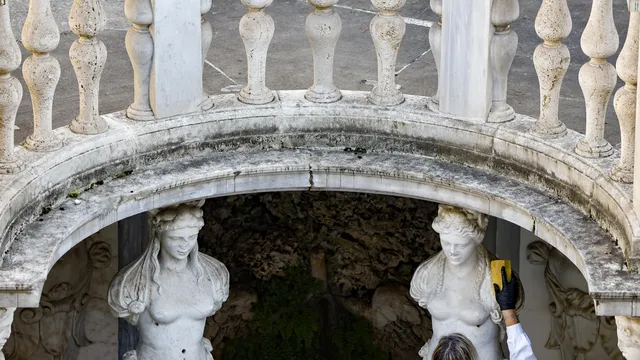Amid the sprawling ruins of the Baths of Caracalla in Rome, hundreds of seagulls circle restlessly, their piercing cries reminiscent of the voices that once echoed here nearly 1,800 years ago. Today, what remains of one of Rome’s largest bath complexes stands mostly empty, except when it hosts opera performances, Slate reported.
But what did the baths look like in Ancient Rome, and why were Romans so passionate about public bathing?
Baths everywhere
In Rome, remnants of ancient baths (thermæ in Latin) can be found all over the city. Almost every emperor built baths, and by the mid-4th century, Rome boasted as many as 952 public baths.
The largest among them were the baths built by Emperor Diocletian (284–305). Every day, around 3,000 people could bathe in this colossal complex, which covered 13 hectares. Like most others, these baths included a hot bath hall (caldarium), heated by an intricate system of air channels in the walls and floor—so hot that visitors had to wear wooden clogs to avoid burning their feet.
From there, bathers would move to a warm bath hall (tepidarium)—a kind of transition to the cold room (frigidarium), which had a pool with icy water. The central element of the building was an open-air pool and courtyard covering 4,000 square meters.
Public baths also featured sports grounds, ball game halls, barber shops, hair salons, libraries, restaurants, and bars.
“Baths, wine, and sex make life worth living”
The philosopher Seneca, who was also an advisor to Emperor Nero, lived above a public bath complex around 50 AD. He described the baths as a place filled with deafening noise:
“Imagine every possible sound that could make you hate your own ears; when athletes train with weights, while straining—or at least pretending to strain—I hear groans, and when they breathe in, they let out hissing and sharp noises. Add to that those who jump into the pool with a loud splash. But besides them, whose voices are at least ordinary, think of the shrill voices of the depilators who shout to be heard and fall silent only when they’re plucking an armpit, then make the client scream instead. And then the different cries of the pastry cook, the sausage seller, the pie vendor, and all the waiters from the taverns who list their goods in a distinct sing-song chant.”
According to a 4th-century account, aristocrats sometimes arrived at the baths accompanied by around fifty servants. Parts of the baths were set aside for these wealthy visitors, who adorned themselves with their finest clothes and most dazzling jewelry.
The baths were a stage for an intense social life—a place for meetings and conversation, where people could show off their bodies and attributes. Large public baths were built and financed by wealthy Romans or directly by the emperor, but there were also many smaller private baths. Admission was often free during public holidays and political campaigns, and at other times was cheap enough that every social class could enjoy them.
Men and women bathed separately and visited the baths at different times of day. Some complexes even had special sections reserved only for women. The physician Soranus of Ephesus, author of a 2nd-century treatise on gynecology, even recommended that women visit baths to prepare for childbirth.
In an overcrowded and polluted city like Rome, the baths were a true oasis of tranquility. The hot water, the scent of perfumed oils, the massages, and the atmosphere itself brought pleasure to everyone.
An inscription from the 1st century read: “Baths, wine, and sex make life worth living.”
Baths and the grim side of slavery
The baths were places of noisy, lively life where people gathered and socialized, but also spaces where some could display their bodies and wealth.
Archaeological evidence even shows that people could clean their teeth there.
Baths were built even in military camps to provide comfort to soldiers during their service.
Yet behind this glamorous picture lay the harsh reality of slavery. It was slaves who did the hardest work—cleaning the halls and furnaces, emptying the toilets, and maintaining the sewer systems.
Slaves accompanied their masters in the baths, massaged them with oil, and cleaned their skin with a strigil—a bronze tool resembling a scraper. They entered the complex through a separate entrance.
Baths across the empire
Baths were popular in every city of the Roman Empire. A famous example is the complex in the city of Bath (Somerset, England), known in the past as Aquae Sulis. There, a natural hot spring fed the baths dedicated to the goddess Minerva Sulis.
Similar remains have been found in North Africa, Spain, and Germany. The massive ruins of a Roman bath in Baden-Baden, Germany, are particularly impressive. In Toledo, Spain, archaeologists uncovered a public bath complex covering nearly one hectare. | BGNES

 Breaking news
Breaking news
 Europe
Europe
 Bulgaria
Bulgaria







